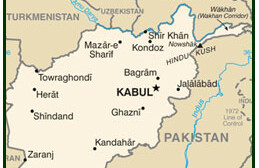Introduction
The Carnegie Council's U.S. Global Engagement program has paid close attention
to developments in Afghanistan, and to U.S. and NATO military engagement, through
a series of policy papers, through guest speakers and special meetings—all
of which are available here.
Ten years into this seemingly intractable conflict, there is a new drumbeat to be heard—not that of war, and for an endgame through military force, but for a political solution. In a recent Financial Times article, "How the U.S. intends to end the war with the Taliban" (18 April), Ahmed Rashid writes:
"After more than two years of internal disputes and rivalries, the Obama administration is for the first time united on stepping up its secret talks with the Taliban. It also wants to start wider talks with regional countries such as Pakistan, which holds the key to a peaceful settlement as the U.S. and NATO prepare to pull out their troops by 2014."
Accommodation with the Taliban, however distasteful to many, including women's rights interests in Afghanistan, is also advocated in the report of a task force cochaired by Lakhdar Brahimi, former UN special representative for Afghanistan and Thomas Pickering, former U.S. undersecretary of state. A second key element of a positive political solution is articulated here by Giandomenico Picco, former high-level UN negotiator. Picco argues, first, that we may have to set aside the notion that Afghanistan must remain a unified, centrally governed state; and second, that a pan-regional dialogue among critical countries—including Pakistan, India, Iran, and Saudi Arabia—is essential for a favorable outcome. Picco's sobering, sensible conclusions may help bring an end to the latest conflict in a place that has embroiled great powers, from the British in the 19th century to the Soviets and now the U.S.-led NATO alliance—and all with the same calamitous consequences.
--David C. Speedie, Director, U.S. Global Engagement Program
The "enemy" has been a primordial tool of government management. For a large part of human history, the "enemy" has helped to define the identity "of the other side." Extremist narratives need an "existential" enemy, and this was often exploited by dictatorial or insecure rulers; such regimes are defined by "the negative other," as they seem unable to provide a full identity by themselves; thus they cannot survive without an enemy. History is full of such cases, and we still see some examples today.
Are there leaders who can lead without an enemy? Great leaders certainly do not copy the pages of the past. They write new chapters of human history, both morally and institutionally. They built national projects around positive values and they have the courage to look into the unknown. A bad leader uses negative narratives rather than positive values. He looks for an enemy—so he can stay on top. He repeats the old adages: "we are better than others," or "God is with us," which imply the need for an existential dichotomy between "us and them;" this requires the demonization of the "other." Statesmen are defined by institutional and cultural innovation while the furthering of negative images of the "other" is the trademark of lesser rulers.
The past four decades of Afghanistan history have offered many examples of the latter. It seems to me that the Soviet project of the 1980s, the Taliban project of the 90s, with its roots in the "extreme Islamisation" of the Pashtu by President Zia Ul Haq (in good part to deal with the Pashtunistan issue), and to a significant extent, even the Western project of the last ten years, may all have something in common. For different reasons those projects seemed to have moved far away from the original "national project" which kept Afghanistan in one piece since 1747, even though some territory was lost in the East and in the West of the country (one part became part of the Persian empire and another became part of the Mogul empire).
The Kingdom of Afghanistan had a national project which was centered on three pillars: two of domestic reality and one of external reality. The first domestic pillar was the organizational principle of "primus inter pares," the "primus" being Kabul and the Pashtu tribe and the "pares" being the other regional areas under the daily rule of other tribes or sub-tribes, as managed by their elders. The second pillar was a division of "church and state;" the religious centre was the mosque, the "civil side" of life was run by the "hujrah," the group of elders. Over the last 40 years or so, the concept of "primus inter pares"—the separation of civilian and religious sides, as well as the tribal construct—in other words, the basic ingredients of the national project—all appear to have been undermined to different extents.
The third pillar was rooted in the international reality of time past: The buffer concept was directly connected with the meaning of distance of another era, when neighbors were restricted to those who were contiguous, in that they alone could affect our daily life. That reality has been superseded by technology, globalization, and a world economy that is no longer local or national. If neighbors are those who can impact our daily life, then today they are also those who live thousands of miles from us. The role of an isolated state between empires or superpowers is gone. Afghanistan can no longer be a country "protected by its mountains" since borders today have a different meaning than they did 100 years ago or more.
The Soviets, the Taliban, and the Western actors appeared to look at Afghanistan as a somewhat centralized state, where they had their proxies in control of Kabul. (Note that the Taliban project has its roots in religious extremism, from the Deobandi roots of the madrassas where most Taliban were taught, together with elements of Wahabism. This provided the Taliban with a Weltanschauung where national borders were less important than religious borders.)
The Soviet, the Pakistani (Taliban), and the Western national project for Afghanistan all seemed to be still part of a vision of a Westphalian nation state. While one could argue that Afghanistan never was a Westphalian state (this is a matter of historic debate), the fact is that the very world of Westphalia is morphing into something that has yet to emerge fully. The Westphalian nation state has a successful secret weapon—namely what Amartya Sen calls the "choice-less identity," the communitarian view of identity, where identity is derived from one's mother and the land of one's birth. Yet this nation state, cannot, in my view, be the last invention of social and political institutions. Is it not the case that we may well see the emergence of post-Westphalian states in various part of the globe within the next decades, perhaps starting in Europe, or perhaps in South Asia?
Thus, the real issue for Afghanistan today is what, if any, is its "national
project"? It cannot be a buffer between empires, it cannot be a ping-pong
ball between India and Pakistan, and it cannot be a springboard or a safe haven
for terrorists who aim to strike countries far away.
Some may say that the national project of Afghanistan for the 21st century is
still being defined by "the enemy," as it has been for centuries.
Over the past three decades the world has come to know about Afghanistan because
of war and destruction. This cannot be the way to shape a national project.
Surely the Afghans deserve better than that? Everybody deserves better than
that.
And so we are back to the question of leaders who can lead without an enemy. Can a future nation be built if the corner-stone of the edifice is the enemy?
Negotiating the future of Afghanistan
The first issue is whether it is even possible to return to a loose unitary state among the various groups/tribes and if it is possible to do so without tempting its neighbors to take advantage of it. More than one nation state in the region relies on an existential—or at least a national—enemy to pursue their respective projects to different extents.
There may now be a different framework for negotiations between various countries—and among Afghans themselves. These days, some of the Afghan actors are playing a transnational role, operating across borders. Several countries are active on the chess board of Afghanistan and some Afghan groups may find their current position impossible to negotiate, as it would mean putting the clock back 40 years. Much has happened in the last decades, especially with regard to a deterioration of tribal relations, while a more centralized constitution was adopted in January 2004. The Afghanistan of the 1970s, or earlier, is no more and I doubt it can be reconstructed.
At the same time, the anti-Indian dimension of the Taliban phenomenon, both inside and outside the borders of Afghanistan over the last several years, raises the question of what can be an "effective" Pakistani role on the Afghan question without an Indian contribution to the mosaic? However, the possibility that New Delhi would accept to be clustered with Islamabad and Kabul in a limited tripartite setting to sort out the Afghan quagmire is rather unlikely. The presence of Iran in the negotiations would be justified by the Shiite Tajiks/Hazaras and the anti-Taliban role that Tehran played before 2001, and indeed by its continued influence as a neighbor. Equally, Indian and Iranian participation would likely encourage Pakistan to call for a Saudi presence at the table. The closeness of Riyadh and Islamabad over the last three to four decades may not have been a subject of interest to many but it has assumed a great significance both on the religious, economic and political fronts. Again, there is both an anti-Indian dimension and an anti-Iranian dimension to the linkage.
A "minilateral approach to negotiations" on Afghanistan, engaging Pakistan, India, Iran and Saudi Arabia, could be complemented by a slightly larger table which would include the U.S., NATO, the EU, Russia and China—nine participants plus Afghanistan.
So what are Afghanistan negotiations supposed to produce and who can make such negotiations successful?
Afghans will have to agree, of course, on the kind of nation state Afghanistan can and should be. The extreme Islamisation of the Taliban refers basically to the Pashtu tribe, as President Musharraf himself stated: "The Taliban are Pashtu and the Pashtu are Taliban." Events inside Afghanistan between 1996 and 2001—i.e. the quasi genocide of the Hazara by the Taliban, the tribal war between them and the Tajiks, and the new political and military role the Tajiks have taken on in Kabul after 2001, may be at the core of an impossible compromise. Will the Tajiks accept going back to their valleys and will the Hazaras be able to forgive the Taliban?
It is equally important that any agreement reached among the Afghan players is supported by its neighbors and other states. This is especially true because a loose federation may well be a possible result of the process among Afghans. In this case, the support of the neighbors would be even more relevant. A code of conduct vis a vis the new Afghanistan by all participants to the negotiations may well help the entire future of the region.
Furthermore, it is evident that several issues of the Afghan saga are inextricably connected with issues between its neighbors, and these problems would have to be addressed in some way—even if not completely resolved—if an Afghan solution is to be given a fighting chance.
Thus the existing Afghan borders, as they have been known over the last 60 years, may well have to be reaffirmed by all participants and declared by the neighbors to be "beyond temptation," so to speak. Their participation may also give further support to the new Afghanistan agreed upon by the Afghans, which may be a new version of a state different from the Westphalian model or those devised by the West.
"Multiple identities" may be the way to go. One can be a Tajik and an Afghan—a Tajik by language, religion and culture, yet with loyalty to an Afghan identity different from that of its neighbors. "Kabul as an open city" may be another result of an intra-Afghan dialogue, and a new version of a unitary state, a confederation of sorts based on features coming from the 1,000-year history of those valleys, and others that Afghans may yet devise, learning from the horrors and mistakes of the last 40 years, mainly characterized by "the demonization of the other." In other words a unique, state which the world has yet to see: a state which would be sustainable both because of the commitments of the Afghans, and because of the commitments of its neighbors and the other participants to the negotiations.
Intra-Afghan negotiations offer a great opportunity, for they will have to produce a "new Afghanistan" or witness the de facto end of the country. The choice is so stark because the old pieces of the construct are no more and the new ones require great leadership—if they are to be put together without leading to a failed state, with further disintegration likely. The option of inventing a new national project based on an outside enemy contains within it the seeds of its own disintegration. Different parts of the Afghan nation may well see different enemies and not the same enemy for all.
To create a national project on the strength of a negative concept, namely "the enemy," raises the question of what kind of leaders does that nation have? Negotiations have to include a number of actors and interconnected issues and they have to be tackled looking forward not backward. Any construct built only on the concept of enemy will destabilize more than one country in the region.
The "minilateral" framework may also make it easier to leave the entire religious issue outside the room, as the participants at the table would be rather heterogeneous when it comes to religious traditions.
Indeed the minilateral approach would offer also the "benefit" of having more than "two sides" to an issue and thus offering more than just "zero sum solutions" to any given problem. It would seem to me that to solve the issues involved requires more imagination than a simplistic "friend-enemy" approach.
I would submit that this is indeed the key to successful "minilateral" negotiations of the Afghan quagmire: the realization that the seeds planted over the last 40 years may in fact undermine more than just Afghanistan.
The umbilical cord between the Taliban and Al Qaeda must be severed, along with links with any other group which uses these territories as a springboard for terrorist activities in other countries. This will have to come to an end—in deeds, not just in words. To achieve this, a number of individuals must be handed over to the countries they have attacked.
Negotiations on Afghanistan by a limited number of countries offer in my view, the chance to lay the foundations of a new geopolitics for the region and more.
From a forgotten Central Asian country in the 1960s and early 1970s, to a land of East-West confrontation in the 1980s, to a failed, discriminatory religious state in the late 1990s, Afghanistan could go on to offering a potential encounter of different religions and cultures and an opportunity "to re-set the geopolitics of an entire region and more." A nine-country negotiation may become the harbinger of a new world set-up, where national projects will no longer necessarily be based on a "choice-less" identity and on an "existential enemy."
In 1942, in the middle of the Second World War when Germany was in the ascendancy, a few leaders, a very few indeed, gathered to design the project for the international system that would emerge after the war. They invented the multilateral system of the UN and Bretton Woods, and so it came to pass after 1945. That construct worked for some 45 years till the early 90s, when the change in geopolitics and globalization affected the functioning of the structures which had served us well for nearly half a century. In particular, the five years between 1986 and 1991 will go down in history for the successes of the 1945 construct, especially in conflict resolution: the Geneva Agreements on Afghanistan, the end of the Iran/Iraq war, the independence of Namibia, the liberation of Kuwait, the end of the civil war in El Salvador—these marked the apogee of this international system and its institutions. Those achievements compare rather starkly with what followed between 1992 and 1997: Balkan wars, Somalia, genocide in Rwanda, conflicts in the neighboring countries of central Africa, some of which continue to this day—and indeed, also the descent of Afghanistan into a failed state, which really accelerated following 1992, to reach a new depth by 1996 and the subsequent years. Indeed, successes in conflict resolution have been hard to come by ever since via the multilateral structure of 1945.
The world has changed in the last few decades. The multilateral system is changing. Six-party talks on North Korea, five plus one on Iran, six on Kosovo, Group of 20 for economics—this is not the profile of the post-WWII multilateral system, with its 1980s successes. We are moving from "multilateralism to "minilateralism." The old construct was based on the belief and reality that major countries were powerful and small countries were weak; in today's global and interconnected world in so many dimensions anybody can be a superpower for 15 minutes. But the invention of a new modus operandi and structures for the new international reality will need leaders who can imagine the empty pages and fill them.
Conclusion
Will the Afghans find leaders who will not mistake conciliation for fear, and forbearance for weakness? A "minilateral" forum at two levels, "intra-Afghan and regional," may offer an opportunity to change the paradigm of the lost and unrepeatable political project for Afghanistan, and some of its neighbors. It may offer countries like Saudi Arabia and Pakistan and others the chance to take on a leadership role rarely offered by history and not yet written; it may also assist in introducing a new dimension within the international cultural/civilizational and political discourse that goes beyond "the choice-less identity" and beyond the "existential" need for an enemy.




